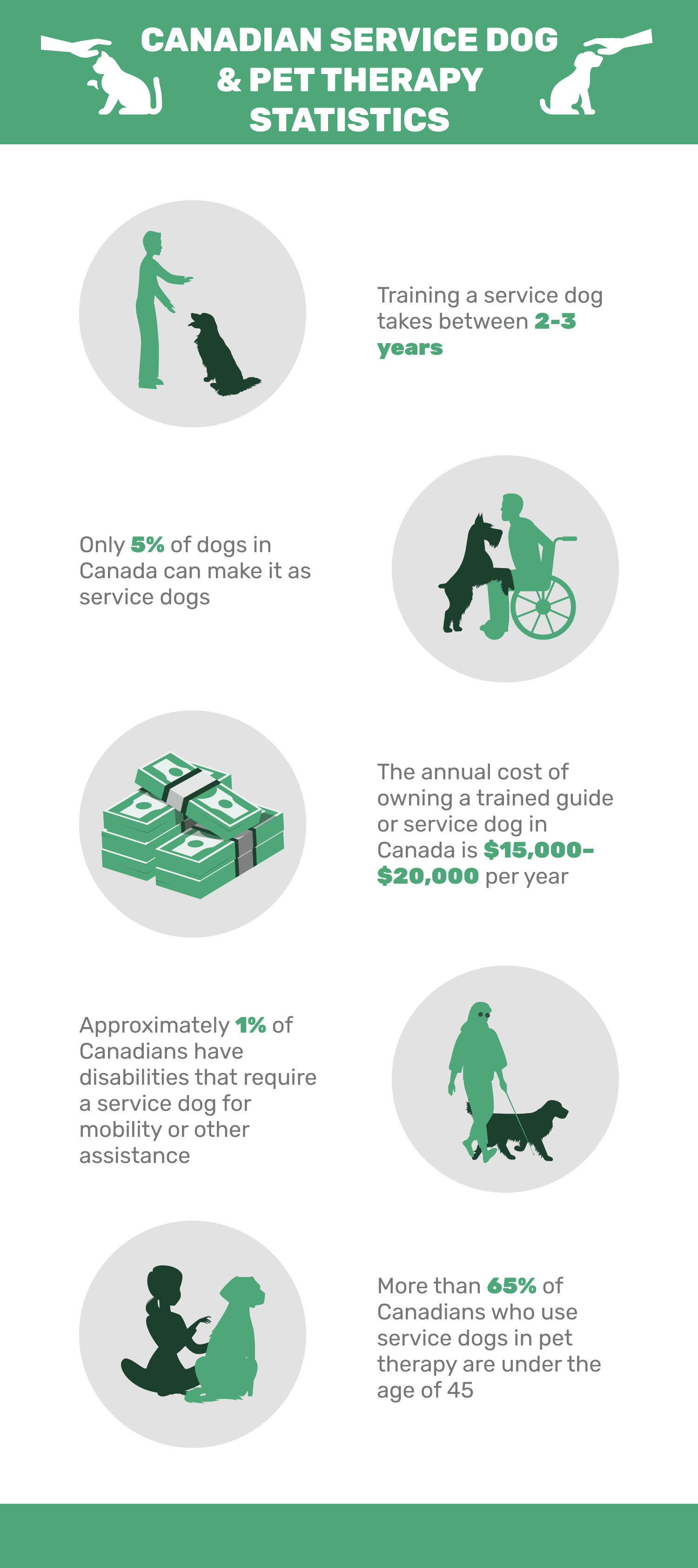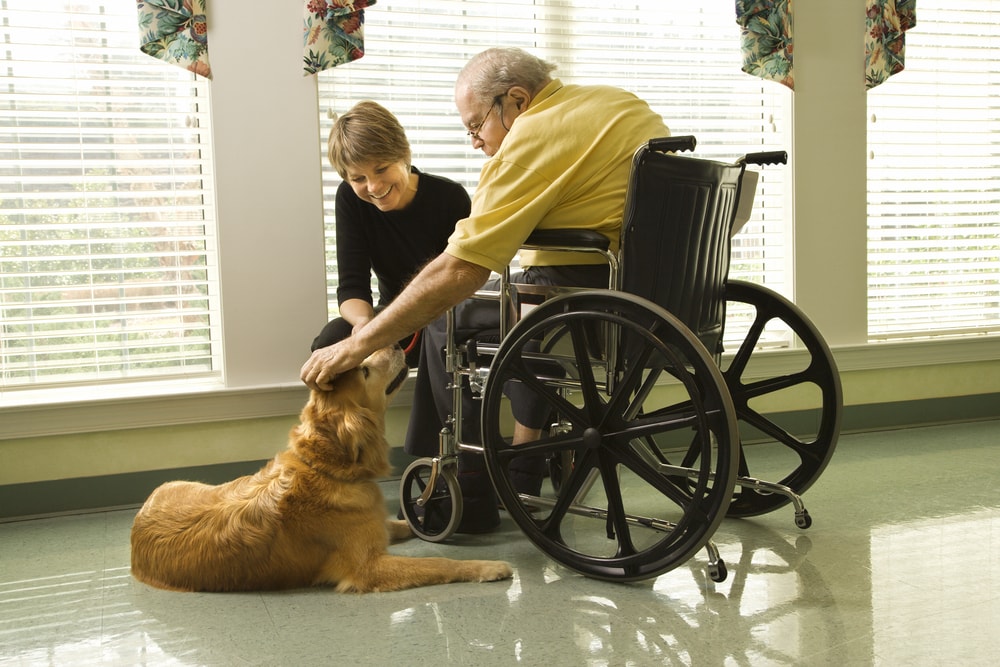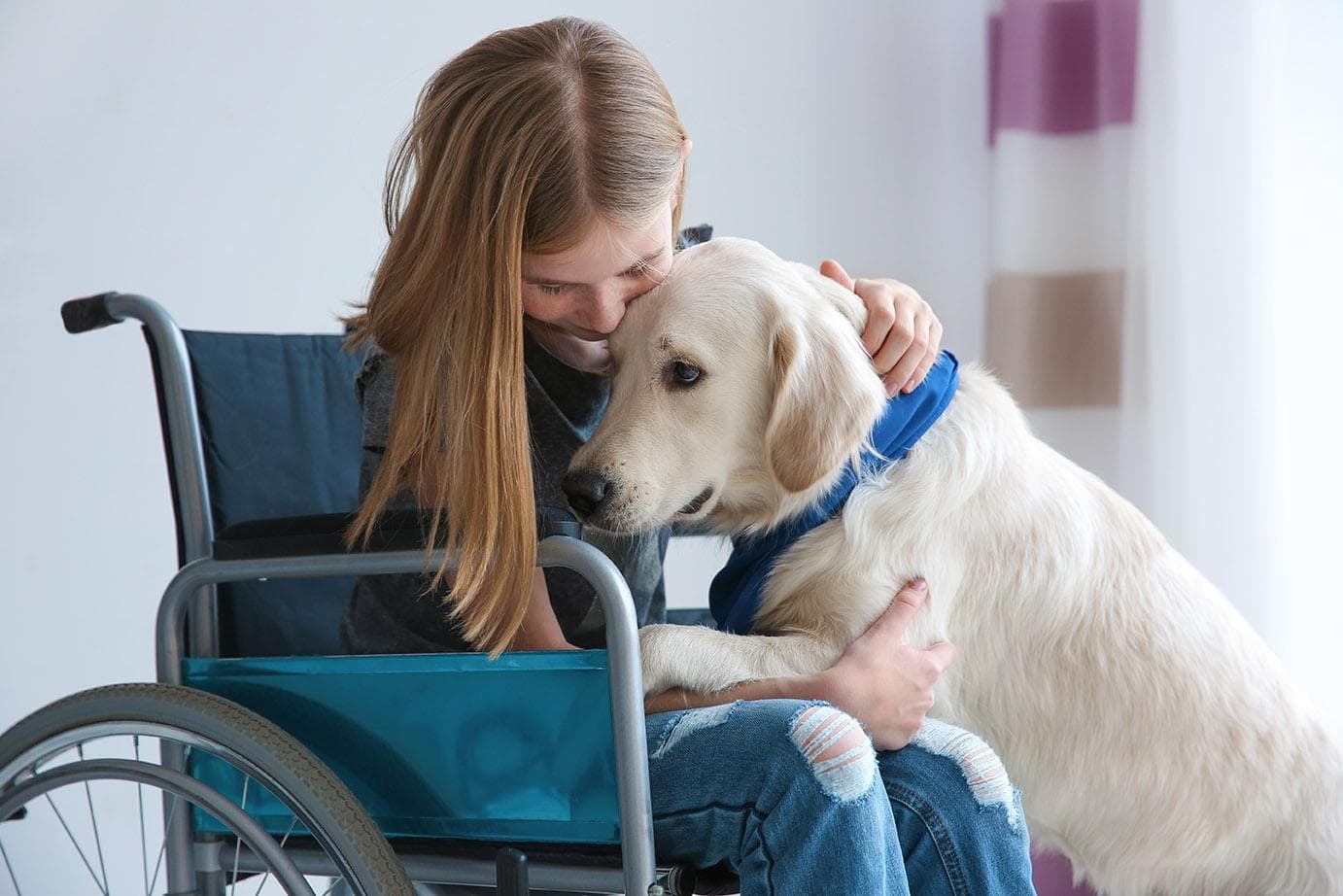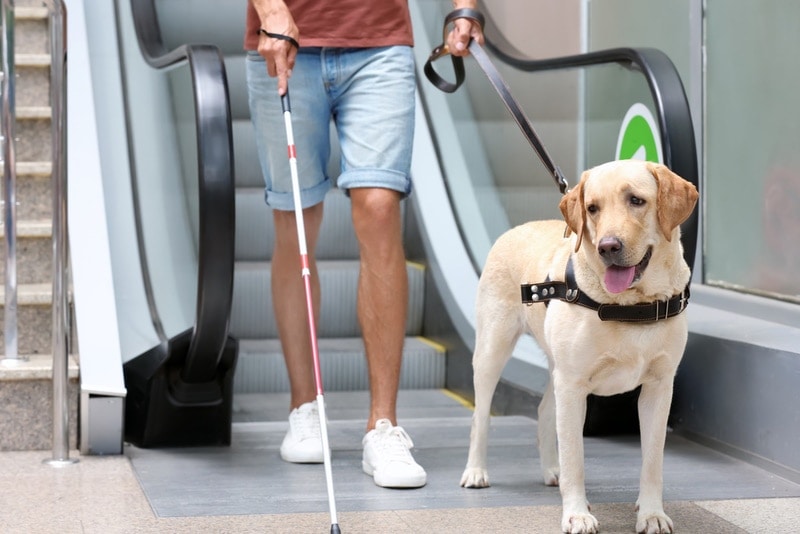Click to Skip Ahead
Note: This article’s statistics come from third-party sources and do not represent the opinions of this website.
Dogs and other pets have proven to be valuable human companions for centuries. Although their roles in our lives have changed, they are still part of our social and cultural heritage. Currently, there’s a high demand for pet therapy in hospitals, nursing homes, and schools. As healthcare facilities become more accommodating to the needs of psychiatric patients, it has become apparent that pet therapy impacts patient health positively and reduces stress levels.1
Service dogs and pet therapy programs have become more common in Canada today with the rise in pet therapy programs. Here, we look at recent Canadian service dog and pet therapy statistics. They paint a picture of how the service dog and pet therapy industry is growing and what you can expect in the future.
The 10 Canadian Service Dog & Pet Therapy Statistics
- Training a service dog takes between 2–3 years.
- Only 5% of dogs in Canada can make it as service dogs.
- The annual cost of owning a trained guide or service dog in Canada is $15,000–$20,000 per year.
- 93% of animal owners agree that veterans with PTSD should have service dogs.
- Approximately 1% of Canadians have disabilities that require a service dog for mobility or other assistance.
- More than 65% of Canadians who use service dogs in pet therapy are under 45 years.
- People with disabilities report fewer falls and trips when they have a service dog to assist them.
- One 30-minute-long session of animal-assisted therapy (AAT) reduces loneliness significantly.
- In Canada, there are over 500 registered pet therapy agencies that are legally able to perform animal-assisted therapy.
- Pet therapy can reduce chronic pain and stress in patients by up to 20%.

Cost and Training of Service Dogs
1. Training a service dog takes between 2–3 years.
(FRONTIERS)
Service dogs can be trained to make a significant difference in the quality of life for people with disabilities. They are trained to perform specific tasks such as opening doors or retrieving dropped objects. They can also help people with mobility difficulties.
A service dog needs 2–3 years of training. However, several factors can speed up the training process. If you have a dog at home, it might be easier to train it than to find a new dog. But if you have health concerns that may make it challenging to train a new dog yourself, consider having one specially trained by a service dog organization.

2. Only 5% of dogs in Canada can make it as service dogs.
(UDS)
But when you look at service animal statistics, only a small percentage of dogs can be trained to become service dogs. However, as seen, only a small percentage of dogs can qualify as service dogs.
The criterion used to group one as a service dog varies from organization to organization. Some require the animal to be trained by a professional. Others accept pets that have little training background but need some additional training.
The majority of these dogs are Labrador Retrievers, Golden Retrievers, and German Shepherds. Others include Bernese Mountain Dogs, Great Danes, Border Collies, and Pomeranians.
3. The annual cost of owning a trained guide or service dog in Canada is $15,000–$20,000 per year.
(Badge of Life Canada)
There are a lot of costs associated with owning a service dog. It’s not as simple as buying the dog and taking it home. Service dogs must be trained to help their partner, and they are expected to work for eight to ten years.
In Canada, the annual cost of a service dog is about $15,000–$20,000 divided for food, veterinarian care, grooming, and ongoing training.
The cost is also inclusive of specialized equipment such as harnesses, vests, and transportation to and from the dog trainer’s facilities. Equipment costs vary depending on the type of work your service dog will be doing.

Importance of Service Dogs & Who Needs One
4. 93% of animal owners agree that veterans with PTSD should have service dogs.
(FRONTIERS)
Service dogs are becoming more popular with veterans with PTSD. It’s a great way for them to move on from their past and focus on their future. There are many things that these service dogs do for the veterans, such as alerting them if they have a panic attack and keeping them calm.
These dogs can also sense if the veteran has a flashback or PTSD episode, and they will go beside them and lay down. Pet owners recommend that veterans should have service dogs.
5. Approximately 1% of Canadians have disabilities that require a service dog for mobility or other assistance.
(CTA)
Service dogs have been specially trained to help people with a wide range of disabilities. They can help a blind person or someone with low vision to pick up items they dropped. They can also alert one with limited hearing when someone is coming or going.
These dogs receive specific training depending on the task they will be performing. But mostly, they assist persons with disabilities. They do tasks that their handlers cannot do because of their disability.

6. More than 65% of Canadians who use service dogs in pet therapy are under 45 years.
(NCBI)
The majority of people who use service dogs in pet therapy are under 45 years of age. Service dogs in pet therapy provide a unique form of animal-assisted therapy. They help people in all kinds of ways.
The therapy can be provided by dogs trained to perform tasks for a person with a disability or by dogs trained to interact and play with the client. From the comfort of their own homes, clients can enjoy the therapeutic benefits of this relationship.
7. People with disabilities report fewer falls and trips when they have a service dog to assist them.
(WHO)
Trip and fall injuries are a significant problem for older adults, particularly those with disabilities. They can be life-threatening, resulting in head injuries, broken bones, and long-term disability.
Service dogs can help people with physical disabilities get around more easily. They can be trained to retrieve dropped items, open doors, and even alert their handlers when it’s time for medication.
A recent study indicates that service dogs also have the unique ability to prevent their handlers from stumbling in the first place. Apart from helping people with mobility issues, service dogs may also provide stability. They serve as a reminder to stand up straight, move slowly, and pay attention.

Pet Therapy Agencies & Therapy Duration Statistics
8. One 30-minute-long session of animal-assisted therapy (AAT) reduces loneliness significantly.
(CBC)
Animal-assisted therapy is also known as pet therapy. It has a positive effect on the well-being of older people living in long-term care institutions. It’s a promising approach for the prevention of institutionalization often triggered by loneliness.
A 30-minute therapy can be an effective intervention to reduce loneliness in older adults living in institutionalized care.
The good news is that it can be alleviated using animal-assisted therapy (AAT). This type of therapy is physical contact between animals and humans.
9. In Canada, there are over 500 registered pet therapy agencies that are legally able to perform animal-assisted therapy.
(EMENTAL HEALTH)
Pet therapy is a growing field and is effective for a variety of ailments. Canada alone has over 500 pet therapy agencies, including hospitals, healthcare facilities, schools, and other institutions. Some of them use dogs, cats, birds, rabbits, and even horses and pigs.
The animals are trained to interact with people through physical contact. The purpose of pet therapy is to improve the mental health of patients. But it also helps with their physical health.
It has been proven that therapy animals help reduce blood pressure, cholesterol levels, and respiratory problems like asthma.
Many families can provide their pets as therapy animals. However, some situations may require the support of a licensed pet therapist to help through the healing process.

10. Pet therapy can reduce chronic pain and stress in patients by up to 20%.
(NCBI)
A recent study conducted by the National Center for Biotechnology Information (NCBI) revealed that those with depression, anxiety, or chronic pain experienced an average drop in pain and anxiety symptoms by 20% after interacting with a therapy dog.
The study also shows that people who work in close contact with animals have reduced stress. Animal-assisted therapy helps people suffering from physical illness or other disabilities. It reduces anxiety in people who suffer from mental health issues.
Treating chronic pain with pet therapy is a new concept. But it’s proving to be beneficial. Different techniques are used for pet therapy, including animal-assisted activities.
Frequently Asked Questions
What percentage of people in Canada use pet therapy?
According to animal-assisted therapy statistics in Canada, the number of people who use pet therapy has increased by 17 percent in the last two years.
Pet therapy/animal-assisted therapy involves using animals to help humans in medical, educational, and social settings. The majority of these therapy visits occur in hospitals and nursing homes. But schools and other organizations also use it.

What anxiety disorders qualify someone for a service dog?
A dog can make all the difference for people with anxiety disorders. These disorders include schizophrenia, bipolar disorder, depression, PTSD (Post-Traumatic Stress Disorder), and anxiety.
The first step towards determining whether a service dog is right for you is to talk to your doctor or mental health professional. It’s because each person’s situation is different. Your doctor will determine whether your symptoms are severe enough to justify having a service dog.
Usually, anxiety disorders fall into two categories. There are panic disorders, which cause sudden intense feelings of fear, and generalized anxiety disorder (GAD). GAD causes long-term feelings of apprehension. Some dogs are trained to help with both conditions.
What are the benefits of pet therapy?
According to research by Paws for People, pet therapy can reduce blood pressure, ease anxiety, and increase happiness. It’s particularly true for people who rarely interact with others.
Also, animal-assisted therapy is used in nursing homes to help the elderly cope with their illnesses. Pets can calm them down and make them feel better. Studies have shown that pets can lower their blood pressure and increase happiness and well-being.
(PAWS FOR PEOPLE)

How many service dogs are there in Canada as of 2022?
Service Dogs Canada estimates that there are over 55,000 service dogs in Canada. This number includes all service dogs, but they can be categorized into seizure alert and response, mobility, psychiatric, autism, and other kinds of assistance dogs.
As more people become aware of how helpful service dogs can be, that number is expected to continue growing. Besides their role in assisting persons with physical disabilities, service dogs are now being trained to assist those with various forms of mental illness, such as post-traumatic stress disorder (PTSD).
(Service Dogs Canada)
How did animal-assisted therapy begin?
The history of animal-assisted therapy spans over 2000 years. The earliest recorded use of animals took place in Greek around 600 BC. There are many instances where animal-assisted therapy was used to heal the sick.
The Ancient Egyptians used dogs, cats, and ibises for this purpose. Other countries like India, China, and Japan also used these animals for similar purposes.
But it wasn’t until the mid–20th century that animal-assisted therapy (AAT) came into practice in North America. Renowned psychiatrist Boris Levinson was a pioneer in this area.
He was drawn to using dogs to help ease the pains associated with child development disorders such as autism, Down syndrome, and cerebral palsy. His observations led to him publishing a book titled “Dogs Are Like That” in 1951, a book that detailed his findings on using animals in pet therapy for children with developmental disabilities.
(PATH INTERNATIONAL)

What are the crucial qualities of a service dog?
Having a disability doesn’t mean you can’t enjoy all the things you used to do. It’s just going to take a little more effort. This is where service dogs come in.
If you are thinking of getting a service dog, it must have qualities such as reliability, good temperament, friendliness, and the ability to follow basic commands. Your dog will be in public most of the time, thus, it’ll be expected to behave well.
Service dogs are trained to help their owners with tasks related to their condition. That’s why they’re well-trained and well-behaved dogs.
(WE CAPABLE)
What are the risks of pet therapy?
Although pet therapy has proven beneficial for many patients with health issues, it comes with some risks. One of the most common risks associated with therapy is allergic reactions like pet dander. It can result in hives, swelling, or even shock if the patient is allergic to any part of the animal.
Pets may also carry bacteria or other organisms on their fur or skin that could cause an infection in the patient’s body.
Some patients may get attached and not be willing to part with a pet once a therapy session is over.

Types of Service Dogs in Canada
Service dogs are trained to assist people with disabilities. It can be a guide for the blind, the deaf, people with epilepsy, and those who suffer from diabetes.
One type of service dog is a guide dog. It assists visually impaired people by guiding them from one place to another.
The other type is a hearing dog. It helps the hearing impaired by responding to sounds such as alarm clocks, doorbells, and smoke alarms.
Also, there’s a mobility assistance dog. It helps physically disabled people get around more easily. It picks up objects that have fallen and pulls wheelchairs.
Another type of service dog is a seizure alert dog. It alerts or responds to seizures. It does this through gestures such as licking, barking, or nudging the person during an episode or in an impending episode.
Besides the mentioned service dogs, there’s a psychiatric service dog that performs specific tasks for a person with mental illness. For instance, the dog can interrupt obsessive behaviors such as handwashing or hair-pulling.
Additionally, there’s medical emotional support dogs. These service dogs provide emotional support. It also helps calm pressure during panic attacks.

Conclusion
Growing up, we all learned that dogs are “man’s best friend,” and nothing could be closer to the truth. While our pets offer us companionship, help keep us healthy, and add a new dynamic to households all over the world, they can also serve a valuable purpose outside our homes.
We may not know it yet, but Canada is home to various therapy pets and service dogs. They spend each day helping patients in homes, hospitals, schools, nursing homes, and more.
Public awareness of pet therapy has increased dramatically in recent years. It has become clear that the benefits of animal-assisted therapy are many. From the comfort they bring to patients in hospitals and senior homes to their ability to aid in the development of children with disabilities, these loyal animals may be the next big thing in healthcare, education, and natural disaster relief.
Featured Image Credit: Krista Grear, Pixabay












